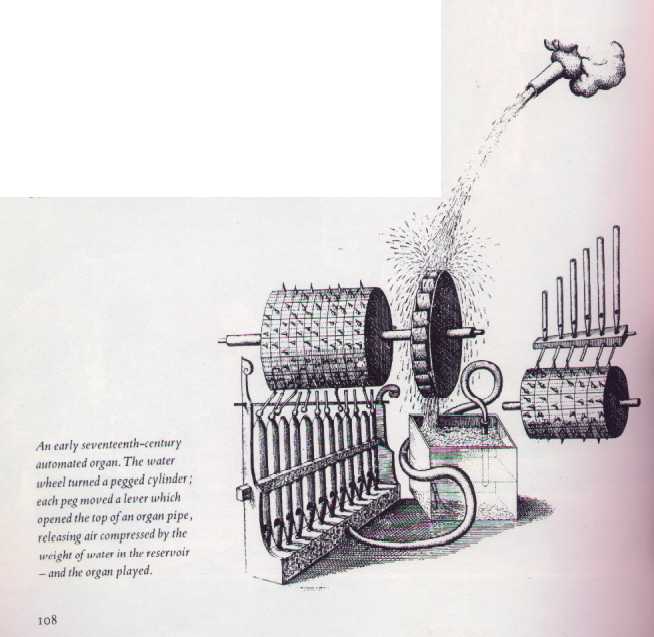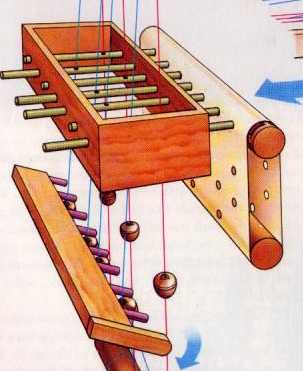
Click on the banner to go back to the home page
Invention Connection
Prepared by Jack Urso, Technology Integrationist for the Virtual Learning Training Center.
Task: Read the lesson below and follow the links for more information. Then answer the study questions.
Objective: Identify the connection between looms and the binary language used by computers.
Some inventions result from the contributions of many people over the course of hunreds of years. For example, aline of invention can begin with the need to produce cloth faster and lead to the development of computer memory storage devices. This lesson will look at how modern computer “memory” storage devices developed over history.
From Weavers to Web Surfers
If we could look at a computer program in its binary language it would look like a series of “0”s and “1”s. This represents an electrical circuit that is either turned off (0) or on (1). Today’s digital computers can talk to each other, like when they’re connected to the Internet through a modem. Information can be saved by storing a series of these 0s and 1s on a hard drive, floppy disk or CD-ROM.
 The
concept of storing information to be played back at a later time is an old idea
that has its origins hundred of years in the past. The first type we will look
at is the “pegged” cylinder one may find in a music box, such as in a jewelry
box. On the left is an example of a water-powered, automated organ from the
1600s (click here for a larger picture). The cylinder
contains the information for the machine to “play” the music. The bars strike
a note and plays music where there is a peg and does nothing when there is no
peg. The musical notes are either 'on" or "off."
The
concept of storing information to be played back at a later time is an old idea
that has its origins hundred of years in the past. The first type we will look
at is the “pegged” cylinder one may find in a music box, such as in a jewelry
box. On the left is an example of a water-powered, automated organ from the
1600s (click here for a larger picture). The cylinder
contains the information for the machine to “play” the music. The bars strike
a note and plays music where there is a peg and does nothing when there is no
peg. The musical notes are either 'on" or "off."
Basile Bouchon, the son of
an organ maker, noticed how the “pegged” cylinder system worked so effectively
to “store” a repeating  pattern
of information for an automated organ. Craftspeople who created the musical
patterns on the "pegged" cylinders did so by punching out a series of holes
from left to right on a piece of paper as a guide to where to place the pegs
on the cylinder. Each song would have its own paper "pattern" a craftsperson
could copy on a cylinder. Bouchon thought the system could be adapted to make
cloth on looms faster by storing the "patterns" that decorates a rug,
blanket or bolt of cloth (for an explanation of what a loom is go here).
To do so Bouchon eliminated the pegs on the cylinder and wrapped the paper "pattern"
around two parallel horizontal dowels (see picture on right or click here
for a larger image).
pattern
of information for an automated organ. Craftspeople who created the musical
patterns on the "pegged" cylinders did so by punching out a series of holes
from left to right on a piece of paper as a guide to where to place the pegs
on the cylinder. Each song would have its own paper "pattern" a craftsperson
could copy on a cylinder. Bouchon thought the system could be adapted to make
cloth on looms faster by storing the "patterns" that decorates a rug,
blanket or bolt of cloth (for an explanation of what a loom is go here).
To do so Bouchon eliminated the pegs on the cylinder and wrapped the paper "pattern"
around two parallel horizontal dowels (see picture on right or click here
for a larger image).
Another inventor, a Frenchman named Falcon (full name unknown), made the system more efficient by flattening out the paper and separating the pattern into a card system, seen here.
The connection between Bouchon and Falcon is explained here.
Where there was a hole in the pattern the loom's weaving pegs went "in." Where there was no hole the pegs stayed "out." By arranging the holes complex patterns could be reproduced on a loom. As a result, loom operators required less skill to produce more and better goods in a shorter period of time for less money.
A Jacquard Card
 A
Frenchman, Jacques de Vaucanson, in 1741 wrapped Bouchon's paper pattern
system around a cylinder and developed a ratcheting system where the cylinder
would advance the pattern automatically. With Falcon’s loom each card had to
be placed manually. Vaucanson's improvement automated the process, increasing
production even more. Another Frenchman, Joseph Marie Jacquard, created
the Jacquard
Loom (see 1801), which incorporated Falcon’s card system with Vaucanson’s
ratcheting system. Falcon and Jacquard used punch cards for their looms that
looked like the one at left. The connection from Bouchon to Vaucanson to Jacquard
can be seen here and explained in detail here.
A
Frenchman, Jacques de Vaucanson, in 1741 wrapped Bouchon's paper pattern
system around a cylinder and developed a ratcheting system where the cylinder
would advance the pattern automatically. With Falcon’s loom each card had to
be placed manually. Vaucanson's improvement automated the process, increasing
production even more. Another Frenchman, Joseph Marie Jacquard, created
the Jacquard
Loom (see 1801), which incorporated Falcon’s card system with Vaucanson’s
ratcheting system. Falcon and Jacquard used punch cards for their looms that
looked like the one at left. The connection from Bouchon to Vaucanson to Jacquard
can be seen here and explained in detail here.
A mechanical computer, called a tabulator,
(click here
for a large photo) was developed by Herman Hollerith for the 1890 U.S. census.
Hollerith  adapted
the Jacquard punch card by arranging the holes in a specific order to
represent census information (age, gender, etc) rather than a decorative pattern
for a rug. Hollerith's card (at right) was placed on a "reader" composed
of pegs that turned "on" an electrical circuit where there was a hole in the
card. Where there was no hole the current was "off." Census information could
then be counted so fast it took years off the time it took to process the information
by hand. Read about Hollerith here
(scroll down to 1890) the view slides 72 to 80 beginning here.
adapted
the Jacquard punch card by arranging the holes in a specific order to
represent census information (age, gender, etc) rather than a decorative pattern
for a rug. Hollerith's card (at right) was placed on a "reader" composed
of pegs that turned "on" an electrical circuit where there was a hole in the
card. Where there was no hole the current was "off." Census information could
then be counted so fast it took years off the time it took to process the information
by hand. Read about Hollerith here
(scroll down to 1890) the view slides 72 to 80 beginning here.
A Hollerith Card
Study Questions:
1) Here are pictures of a Jacquard punch card and a Hollerith punch card again. Do they look similar? In what way? Did both cards store information? If so, how?
2) What was a loom and what did it do? How did it contribute to the development of memory storage devices?
3) True or false: Weavers were happy that Bouchon's card system made their work easier. Why or why not? Explain your answer.
4) What was Herman Hollerith’s tabulator and how did it contribute to the development of computer memory information storage?
5) Is there a connection between the "on" and "off" binary computer language we use to store information and the Bouchon/Jacquard cards used on looms? If so, what is that connection?
Extra Credit: Who were Blaise Pascal and Charles Babbage? What did they contribute to the development of modern computers?